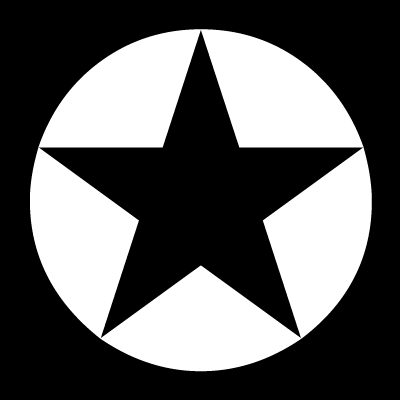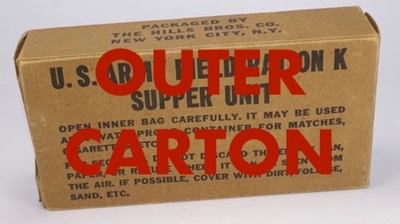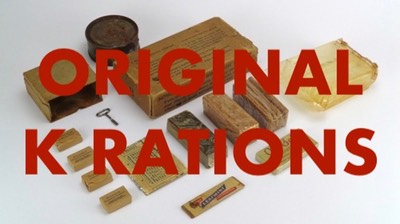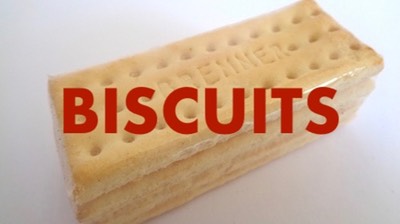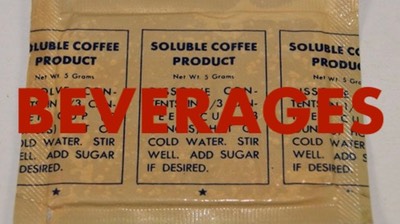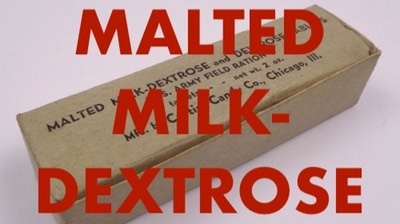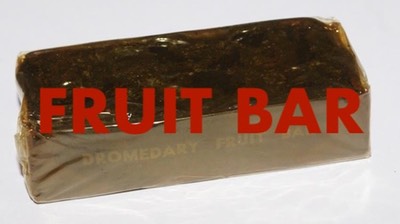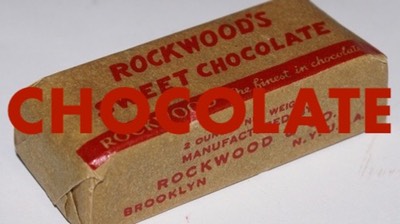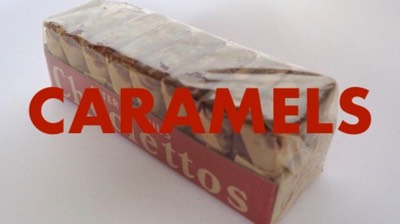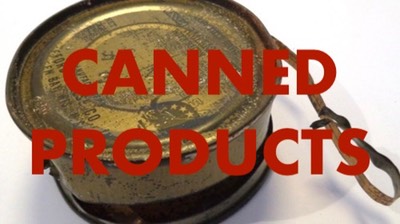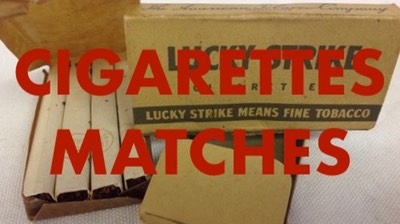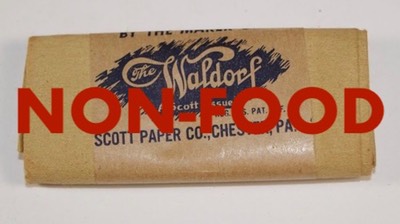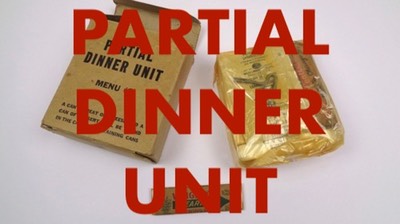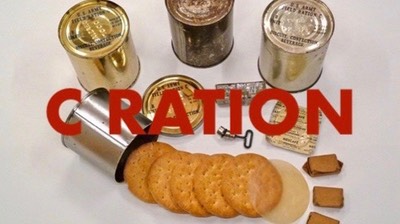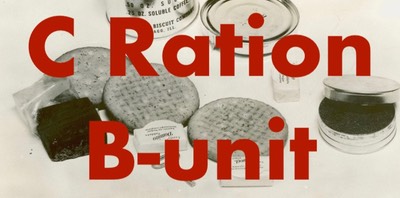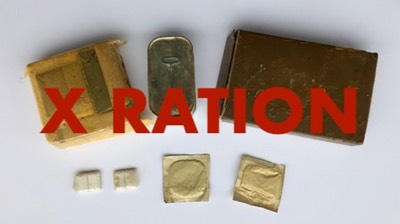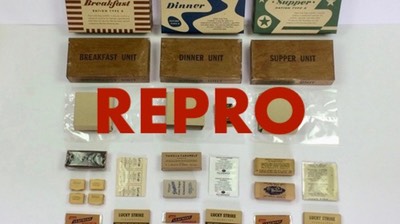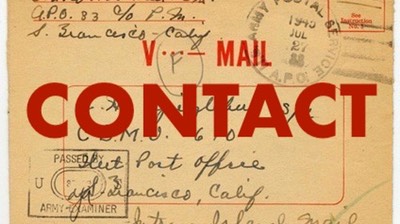
G-3. Packing. Twelve K Rations shall be packed as specified in G-3a or G-3b, and G-3c.
The arrangement of the cartons shall be 12 in length (major panels facing), 3 in width, and 1 in depth.
One row of 12 cartons shall be for breakfast, one row for dinner and one row for supper.
-C.Q.D. No. 28H, 31 August 1945
The Solid Fiberboard Box
Two methods of packing the rations for overseas shipment were used: a Solid Fiberboard Box packed in a wooden case, and later, as an alternative option, a Corrugated Fiberboard Box sealed in a laminated bag placed in a wooden case was also used.

The first and prevalent method is the placing of twelve rations (36 units) in a solid fiberboard box that was overpacked in a wooden case. Early fiberboard boxes were marked on one end with the nomenclature, packing date, contract number and the packing company's name.

Early solid fiberboard box, the markings says it all.

Early solid fiberboard box. Note that the month is hand-stamped, not printed as the box shown above. (photo: 1944Supply)
Later the markings were simplified and a crescent was added identifying its contents as food. But many variety in markings exist, differing from time and contractor.
Official dimensions for the crescent dictates that the crescent is three inch tall and is two inch wide, with the middle being 7/8 inch thick.

A simplefied stenciling on a fiber box. The stencil appears rather crudely hand-made.
(photo: 1944Supply)
A more neatly done simplified label on a December 1943 box.
The side is labeled with both the V3s label and the weatherproof logo, see photo further below. (photo: 1944Supply)

Simplefied markings on a 1944 solid fiberboard box.

Here a Marine is carrying rations to the front. Two gas cans are being carried containing drinking water. These cans were thoroughly cleaned and stenciled "water" and were to be used exclusively for drinking water.
On his shoulder he is carrying a solid fiberboard box with K Rations. The empty wooden cases were often kept for reuse back at the depot.
Other markings were placed on the side or bottom indicating the type or quality of fiberboard used. Early shiping containers were of commercial grade of weatherproof fiberboard. For overseas shipment, however, these were considered inadequate.
The Army developed new shipping containers of a sturdier fiberboard, both solid and corrugated, with better waterproofing qualities known as V-board. Three grades were developed: V1, V2 and V3*.
The type used for the K Ration is the V3 type. (The Ten-in-One Ration was packed in the V1 or V2 type.)
* The V1-board was made of 100% virgin fiber, where the V2-board was made of a mix of virgin and used fiber, and the V3-board was made of almost entirely of used fiber and was therefor to be over packed in a wooden case for overseas shipment.
The addition of the letter “S” or “C” indicates whether the fiberboard is solid or corrugated. An additional “R” added to the V1- and V2-board means that the fiberboard is reinforced with sisal, a fiber from the leaves of the Agave plant. This sisal fiber is laminated with asphalt between the layers of kraft paper. The asphalt serves as an additional protection against water.

On the bottom of the 1942 box is placed the Box Certificate label stating the quality of the fiberboard.

Weatherproof marking on the same 1942 box, shown above, as used on the early commercial shipping fiberboard containers.
Here's an interesting shipping case! Not only is it marked with the V3s label, but also retains the commercial weatherproof logo. Perhaps the manufacturer of the box considered the V3 type equal to their Weatherproof boxes. Note the date: December 1943. (photo: 1944Supply)

Box Certificate label on a 1944 V3 type solid fiberboard box.
Note the metal staples, alternatively referred to as metal stitches.
The Corrugated fiberboard Box
As an alternative, a corrugated fiberboard box was used instead of the solid fiberboard box. The use of corrugated boxes was probably approved at the end of 1943 and usage started in 1944, as indicated by the box shown below dated Januari 1944.
Above: The stenciling on the end panel of a corrugated box. The bottom of this box was closed with metal stiches. This was done before inserting the K Ration units.
Below: the side of the same corrugated box. This example is dated January 1944. Note the V3c marking indicating that it is corrugated V-board grade 3.
(both photos: 1944Supply)

A 3-44 dated corrugated box made by Inland Container Corporation.


Beware of reproductions! This box was made by the Colombia Corrugated Box Co. that was founded in 1967 and carries the recycling logo introduced in 1970. There’s no V3c label on the box but does have the “Ration K 12 rations” plus crescent on one end and the name H.J. Heinz on the side.
Case Liner
Since corrugated fiberboard is not weatherproof, the corrugated box was placed inside a laminated bag for protection. This laminated bag is referred to as a "case liner".
This laminated bag (case liner) was composed of either a triple-ply kraft paper laminated together with asphalt, or a metal foil with cellophane laminate that is laminated with asphalt to kraft paper. After placing the corrugated box in the bag, all air is to be pushed out, without creating a vacuum. The bag is closed with a waterresistant adhesive.

Here's an opened case showing the "case liner". Due to the asphalt compound used in laminating the kraft paper the liner appears quite dark. (photo found on the internet)

Oddly, a recently opened case, dated July 1945, contained a corrugated box placed directly in the wooden case without the case liner. It was stamped "for training purpose only". These surplus K Rations were often used during post war training exercises. Probably it was opened for inspection and then repacked without its case liner.
The Wooden Shipping Case

A fiberboard box rests on the wooden shipping case it came in.
Used by the Phillips Packaging Co. Inc. dated April 1944.
For mechanical protection, the fiberboard or the corrugated box (that is placed in a laminated bag) is overpacked in a wooden shipping case.
The ends and sides are usually made of one-piece panels. (Two-piece panels with tongue and grove connection are used as well.) With the sides having a minimum thickness of 11/32 inch (9 mm), and the ends are made of 3/4 inch (19 mm) thick wood.
The top and bottom are usually both made of two pieces, with the same thickness as the sides. The two pieces preferably having a tongue and groove joint.
Construction of the case is made using cement-coated sixpenny nails.
One end of the wooden case is marked with the letters KS (sometimes placed between quotes) with crescent and its weight and size. Weight increased over time from 39 pounds, to 43, to 45 pounds. Cubic displacement goes from 1.17 (or 1.2) feet to 1.3 and sometimes even 1.4 feet.
Early cases are also marked with the Quartermaster's contract number. On its side the letters KS are repeated and the packers name and packing date is stenciled.

A shipping case with typical late 1942 or early 1943 markings.
Unfortunately the Campbell Soup Co. didn't stamped the date on this case.
Later it was left to the contractor whether this contract number was placed on the front end or the side of the case together with the Company's name and packing date.

Shown here are two cases used by the Phillips Packaging Company. The top case is dated April 1944 and has the contract date stencilled on the side (see photo below).
On the other wooden case the contract number is part of the front stamping and on its side is stencilled only with the name and date: May 1945.
This case also has a small letter K on the bottom.
Note the different cubic displacements, the 1945 case being sligtly longer.

Contract information stencilled on the side of the wooden case showing April 1944.
Later in the war the top and bottom would be marked additionally with a K.

A case made by Phillips dated May 1945 has been stencilled with a small K on the bottom. (This was also done on the top.)

On the inside of the upper part of the side panel can be seen stencilled "KS" of this wooden crate. It appears that this was done to crates used in the US for training and returned empty for reuse. The markings on the returned crate were then changed to the latest specifications. (photo: 1944Supply)

Another variety of the stenciling. (photo: 1944Supply)
It should be noted that the front stencilling is usually done with a metal stamp and is pressed firmly into the wood. The shipping information is usually stencilled on the side by using a mask and brush. Sometimes steel or rubber stamps were used with the date hand-stamped in.

I haven't found out yet why the K Ration fiber boxes and cases are marked "KS". My theory is that the "S" stands for subsistence. The boxes of the Jungle Rations, according to the specifications for this ration, were to be marked with "JS".

An empty K Ration case (circled in red) is lying on Omaha beach. Note the KS marking.
After nailing the wooden case shut it was strapped with either steel wire (referred to as round straps in the specifications) or flat steel straps. The flat steel straps are 5/8 inch wide. The first strap applied ran the length of the case, running from end to end over the length of the top and bottom. Two more straps were applied running from side to side across the top and bottom. Each strap is positioned 1/6th from each end.

A dugout of Marine war dog handlers showing two cases of K Rations. Both cases are strapped with the flat steel straps. Note the empty C Ration can in front of the sand bags.

Here we see a Beech Nut Packing Co. wooden shipping case, dated July 1944, with its solid fiberboard box, still remaining its longitudinal round strap. Below is shown a close-up of how the ends of the steel wire are intertwined.

Although the fiberboard cartons were of a natural tan or beige color and required no additional camouflage coating, the army was concerned that the light wooden boxes would stand out in the field. The investigation of the possibility of camouflage coating the boxes was requested.
A proposed method of spray painting the outside of stacks of rations was deemed impractical because after shipping the boxes needed to be restacked in exactly the same order after arriving at the advanced depots in the combat theatres.
Another idea was to paint the boxes on three adjoining sides (end, side and top or bottom) with a sand color and the other three sides with a green color for desert or jungle environment, respecively, depending on how they were stacked.
Ultimately it was decided that it was the contractors responsibility to camouflage the wooden boxes with a light brown water-soluble stain that would not obliterate the markings. This was implemented as of March 1943.
When K Ration cases were stacked on pallets for shipment, shipping information from the depot was stencilled on one case on each side of the stack in order to identify and keep track of the shipment.

